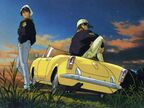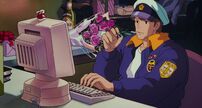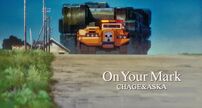let's take a look at the world view of on your mark. In the future world, the ground is invaded by nuclear radiation, and even the sunlight is mixed with the smell of danger. Human beings have no choice but to go underground. The short film is expressed in three ways.
The first is the ubiquitous trefoil logo:
The second is the huge random metal buildings on land:
The third is several warning signs on the roadside: "Dangerous sunshine ahead", "No guarantee of safety, etc.",
Let's see how it tells a story.
Two police officers found an angel when they were destroying a religious group. Angel was caught by a scientific organization for research, and the two policemen felt uneasy all the time. Later, they decisively pretended to be researchers to rescue Angel and took her back to the ground full of sunlight and vegetation. There is a controversial section here, that is, the first time when the two policemen fled with the angel, they crashed into the airship, and the three fell from a height. Then the scene returned to the scene where they met the angel for the first time, and then it was exactly the same. The plot continued until they hit the airship again, but this time, their car was red light in the mid-air crash, and they flew to the residential area, and finally escaped successfully. There are two interpretations of this passage. One is that Hayao Miyazaki has indeed arranged two endings, and the other is that the angel has the function of resetting time and space, turning back time at critical moments.
I think that Hayao Miyazaki's films are more than just wild imaginations. He always walks in various worlds with a bowl of water. This bowl of water prevents him from playing and flying, and prompts him to express his emotional logic clearly even in animated films. Many Japanese animation directors are too strong in their authorship and rely too much on inspiration and passion. The disadvantage of this is that at the end of the writing, they become obsessed, no longer seek communication with the audience, and forcibly escape the rationality and continuity of the characters' motives. Move with emotion. And Hayao Miyazaki is just different, he can get it back at a critical moment. So I think in the short film, he should have arranged for the angel to have the ability to reverse time and space, and only such a turning point can make the short film have a complete story structure, with ups and downs. The former double ending choice seems interesting, but in fact, the plot of each ending appears thin. Of course, I think Hayao Miyazaki also laid the groundwork for the angel's ability to reset time and space. There are many similar flashback scenes in the film, and the scene where they return to the ground at the end is actually what Miyazaki is telling the audience. It is implied that the angel has long perceived the relationship with the two police officers in different time and space, so there is also a momentary picture of the future during the contact between the police brother and her. The first time when the three of them escaped and fell, the angel who had not awakened reluctantly used his ability to return to the moment of their first encounter. In the second escape and fall, the angel further exerted force and made the car fly. The reason why it is controversial is because Hayao Miyazaki used the simplest way to connect the shots when he explained the flashbacks, plus the habitual or even rotten random editing of shots in similar mv shootings around the world, so there are very few audiences. Be aware of the role of these fragmented shots.
Well, let's take a look at the theme expression. I
have to say that the appearance of religious gangs in the film is simply Miyazaki's masterpiece, and it's awesome! Let the sci-fi hard core of the entire future world become three-dimensional in an instant. The LED lights on the building where religious gangs gather are printed with the phrase "GOD IS WATCHING YOU"
It means that this should be an organization of gods similar to the Worship of God, that is, a sect of pseudo-gods. And the angel with divine power is the true God. When angels fall into the hands of religious believers, the essence is a prophecy that the true God will fall into the flow of false gods. Through this setting, Hayao Miyazaki wants to express two meanings: the first is the tragic scene of the true god falling into the mortal world and being devastated by the mortal world, and the second deeper meaning is that the pure quality of the true god, such as the truth, goodness and beauty, is under the chaos of the apocalypse. The embarrassment and helplessness of being imprisoned and replaced by human ugliness such as ignorance and numbness. This is the most distressing disaster. Of course, this setting may not be groundless. French sociologist Le Pen mentioned: what groups desire is not freedom, but enslavement. So no matter who calls themselves their leader, they will instinctively obey. Especially in such a sensitive tone as Doomsday, just imagine the infinite darkness deep underground, under the threat of nuclear radiation all day long, what the blind human group relies on to cheer up—belief! At this time, any daring villain ran out to preach God, preach faith. are likely to be sought after. Because people at that time were too fragile, there was a person willing to come to cheer them up. Unintentionally, it was a help in the snow. Whether their beliefs are true or false is no longer important. It is better for someone to lead a enslaved group than a blind group to stagnate in hesitation.
Of course, such sects may be more popular than imagined, so they will gather in the buildings in the city as recklessly as in the film. This can also explain why they imprisoned the angels. Having a specimen of the true God is the most effective means of attracting believers.
And the incident of the government sending police to annihilate religion is probably not as simple as fighting evil forces.
The driving source of the government has always been interests, regardless of the quality of the government, but the essence of the political system. So cracking down on religion may also hide a natural hostility to groups of different natures, and those in power are afraid of any new group with public opinion. Our history has verified it many times. So you can see that if Miyazaki sets religion as an ordinary violent gang, it is only different from the interests of the government, and the sense of confrontation is not so strong. The turbulent mood and severe conflict of the crowds in the entire post-apocalyptic world is conveyed. We can now glimpse the turbulent contours of that world through the 6-minute short film, which is the height of the religious setting.
http://www.bilibili.com/video/av3485695/
View more about Chage & Aska: On Your Mark reviews







